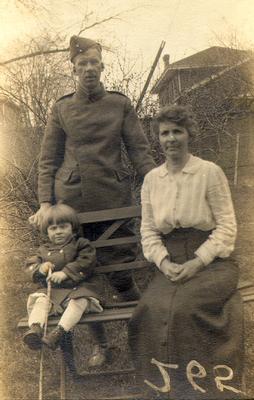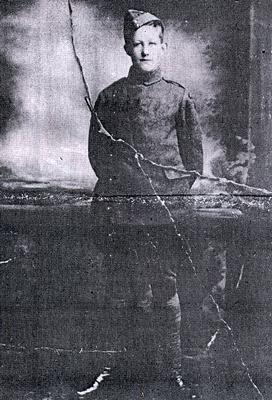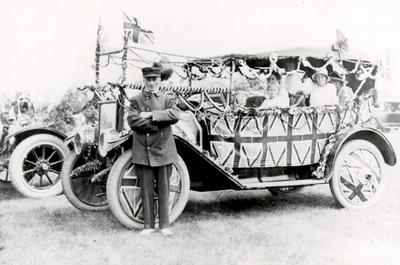
Oakville at War
First World War
Panels
IntroductionFirst World WarSecond World WarFurther ResearchVeterans Interviews (click on Details to play video)More Information
CorrespondencePostcardsWar Images: First World WarWho Served: First World WarCanadian statistics from the First World War tell a grim story. Of the 620,000 Canadian troops who served in the war, 60,000 were killed and 172,000 wounded. At Vimy Ridge, a hard-fought and bloody battle, 3598 Canadians soldiers were killed and 7000 wounded. At Passchendaele, where soldiers fought up to their waists in mud, 16,000 were killed or wounded.
The numbers are overwhelming, yet it is the smaller numbers that carry the more immediate emotional impact: the McCraney family of Oakville saw five sons go to war, all of them wounded; Oakville resident Clara Elizabeth Winter had three brothers and one sister in the war, and her husband, Alfred Samuel Leaver, had three brothers in the army. The Town’s Honour Roll for the First World War shows 63 men from Oakville’s small population of around 2500 did not come home.
Frances Robin Ahern records that the greatest number of Oakville men went overseas with the 164th Battalion, raised from the Halton and Dufferin areas in 1916. When their troop train left, a large crowd gathered to see the soldiers off. The 164th was eventually sent to England where it was broken up to reinforce Canadian units already in France.
Those left at home made great efforts to assist those fighting in the trenches. Women, and men too old to enlist, travelled by train or Radial Car to Hamilton and Toronto to work in munitions factories and essential occupations left vacant by those overseas. The Women’s Patriotic League staged performances in Victoria Hall of St. Jude’s Church and held sales of baked goods and homemade articles. They sent parcels of food and cigarettes to the soldiers and knitted them sweaters, socks, and Balaclava helmets. Even the children sold lemonade from stands in front of their homes.
When news of the armistice came on November 11, 1918, Oakville celebrated the end of the grim war. From accounts in the Oakville Record-Star, noise was the chief indicator of joy. Whistles sounded at 6:00 in the morning to summon everyone to a church thanksgiving service. Fog horns sounded and people banged on tin pans on their way to the service. Later a procession of cars and trucks with horns blasting and “loaded with people hammering any noise-producing article” made its way merrily through town. War songs were sung loudly at the evening’s bonfire. “All day,” reported the Record-Star, “our most sedate citizens engaged in the hilarity and all were overjoyed at the return of peace.”
The numbers are overwhelming, yet it is the smaller numbers that carry the more immediate emotional impact: the McCraney family of Oakville saw five sons go to war, all of them wounded; Oakville resident Clara Elizabeth Winter had three brothers and one sister in the war, and her husband, Alfred Samuel Leaver, had three brothers in the army. The Town’s Honour Roll for the First World War shows 63 men from Oakville’s small population of around 2500 did not come home.
Frances Robin Ahern records that the greatest number of Oakville men went overseas with the 164th Battalion, raised from the Halton and Dufferin areas in 1916. When their troop train left, a large crowd gathered to see the soldiers off. The 164th was eventually sent to England where it was broken up to reinforce Canadian units already in France.
Those left at home made great efforts to assist those fighting in the trenches. Women, and men too old to enlist, travelled by train or Radial Car to Hamilton and Toronto to work in munitions factories and essential occupations left vacant by those overseas. The Women’s Patriotic League staged performances in Victoria Hall of St. Jude’s Church and held sales of baked goods and homemade articles. They sent parcels of food and cigarettes to the soldiers and knitted them sweaters, socks, and Balaclava helmets. Even the children sold lemonade from stands in front of their homes.
When news of the armistice came on November 11, 1918, Oakville celebrated the end of the grim war. From accounts in the Oakville Record-Star, noise was the chief indicator of joy. Whistles sounded at 6:00 in the morning to summon everyone to a church thanksgiving service. Fog horns sounded and people banged on tin pans on their way to the service. Later a procession of cars and trucks with horns blasting and “loaded with people hammering any noise-producing article” made its way merrily through town. War songs were sung loudly at the evening’s bonfire. “All day,” reported the Record-Star, “our most sedate citizens engaged in the hilarity and all were overjoyed at the return of peace.”

James Byron Kelley's enthusiasm to enlist led him to join the Royal Flying Corps, despite significant vision issues. Discharged, he immediately joined the Engineers, transferred to the Medical Corp, and was sent overseas to operate X-ray machines. Details

A returning veteran still persuaded Oakville’s Clare Laing and others that they would be “cowards if we did not volunteer at the recruiting meeting.” Clare later enlisted in the Royal Flying Corps and his brother John joined the 3rd Engineers. Details

A decorated car in one of Oakville's celebrations marking the end of the First World War. Celebrations were held in 1918 on Armistice Day and again in July 1919 to celebrate the return of Oakville’s soldiers. Details

Captain William Sinclair Tuck was killed in action October 30, 1916. He is mentioned in a dispatch from General Sir Douglas Haig for gallant and distinguished service in the field. Details
